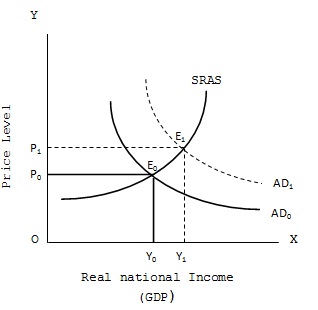A shift in the aggregate demand curve is called aggregate demand shock. If aggregate demand increases because of increase in investment or larger government spending, this will cause an upward (rightward) shift in the AD curve form AD0 to AD1 as shown.
With the initial aggregate demand curve AD0 and the SRAS, the equilibrium point is E0 with equilibrium GDP level Y0 and equilibrium price level P0. An upward shift in aggregate demand shifts the AD curve from AD0 to AD1.This given a new equilibrium position E1 corresponding to which equilibrium GDP level increase to Y1 and equilibrium price move up to P1. Thus, both GDP and price level increase with an upward shift in the AD curve. A decrease in aggregate demand and downward shift of the AD curve from AD1 to AD0 has the opposite effect of redacting both the GDP and the price level.

Aggregate demand shocks cause the price level and real GDP to change in the same direction; both rise with an increase in aggregate demand, and both fall with a decrease in aggregate demand.
SUBMIT ASSIGNMENT NOW!